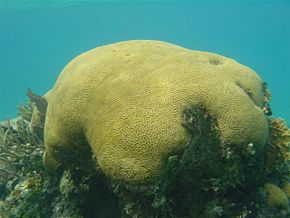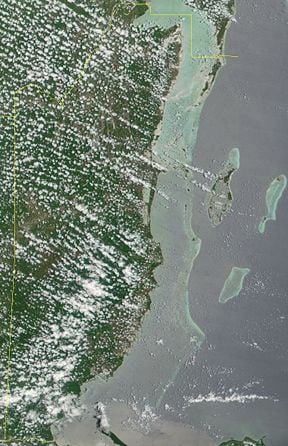Belize Barrier Reef
| Belize Barrier Reef Reserve System* | |
|---|---|
| UNESCO World Heritage Site | |
| State Party | |
| Type | Natural |
| Criteria | vii, ix, x |
| Reference | 764 |
| Region** | Latin America and the Caribbean |
| Inscription history | |
| Inscription | 1996 (20th Session) |
| * Name as inscribed on World Heritage List. ** Region as classified by UNESCO. | |
| Belize Barrier Reef | |
|---|---|
| IUCN Category IV (Habitat/Species Management Area) | |
| | |
| Location: | Belize |
| Nearest city: | Belize City, Belize |
The Belize Barrier Reef is a series of coral reefs straddling the coast of Belize, roughly 300 meters (1,000 ft) offshore in the north and 40 kilometers (25 mi) in the south within the country limits. The Belize Barrier Reef is a 300 kilometers (186 mi)-long section of the 900 kilometers (560 mi)-long Mesoamerican Barrier Reef System, which is continuous from Cancun on the northeast tip of the Yucatán Peninsula of Mexico through to offshore Guatemala, making it the second largest coral reef system in the world after the Great Barrier Reef in Australia. It is Belize's top tourist destination, attracting almost half of its 260,000 visitors, and vital to its fishing industry. Conditions for scuba diving and snorkeling are ideal since water visibility commonly reaches 100-plus feet; water temperatures hover around 80 degrees Fahrenheit; and the barrier reef makes for calm water most of the year.
Charles Darwin described it as "the most remarkable reef in the West Indies" in 1842.
The coastal area of Belize is an outstanding natural system consisting of the largest barrier reef in the northern hemisphere, offshore atolls, several hundred sand cays, mangrove forests, coastal lagoons, and estuaries. The system’s seven sites illustrate the steps in reef development and are a significant habitat for threatened species, including marine turtles, manatees and the American marine crocodile.
Species
The Belize Barrier Reef is home to a large diversity of plants and animals, one of the most diverse ecosystems of the world:
- 70 hard coral species
- 36 soft coral species
- 500 species of fish
- hundreds of invertebrate species
With 90 percent of the reef still needing to be researched, it is estimated that only 10 percent of all species have been discovered.[1]
Environmental protection
A large portion of the reef is protected by the Belize Barrier Reef Reserve System, which includes seven marine reserves, 450 cays, and three atolls. It totals 370 square miles (960 km²) in area, including:
- Glover's Reef Marine Reserve
- Great Blue Hole
- Half Moon Caye Natural Monument
- Hol Chan Marine Reserve
- Cays include: Ambergris Caye, Caye Caulker, Caye Chapel, St. George's Caye, English Caye, Rendezvous Caye, Gladden Caye, Ranguana Caye, Long Caye, Maho Caye, Blackbird Caye, Three Coner Caye.
A marine reserve is an area of the sea which has legal protection against fishing or development. This is to be distinguished from a marine park, but there is some overlap in usage.
Because of its exceptional natural beauty, significant ongoing ecological and biological processes, and contains the most important and significant natural habitats for in-situ conservation of biological diversity, the Reserve System has been designated as a World Heritage Site since 1996.
Despite these protective measures, the reef is under threat from oceanic pollution, uncontrolled tourism, shipping, and fishing. Hurricanes, global warming, and the resulting increase in ocean temperatures are a particularly significant threat, causing coral bleaching.
"There is growing concern that global climate change is degrading coral reef ecosystems, with coral mortality increasing as a result of bleaching and emergent diseases: our results from Belize appear to justify this concern," said Richard Aronson of the Dauphin Island Sea Laboratory in Alabama.[2]
It is claimed by scientists that over 40 percent of Belize's coral reef has been damaged since 1998.[3]
Manatees are also threatened. They were commonly hunted for their meat by natives of the Caribbean, although this is much less common today. The indigenous hunter would use various methods of baiting in order to attract a manatee close enough to hit the animal near the head with an oar-like pole, temporarily stunning the manatee. Many times the creature would flip over, leaving it vulnerable to further attacks. Manatees were also hunted for their valuable bones, which were used to make "special potions." Today, manatees are now considered endangered and protected. One of their main sources of mortality today is collisions with boats and propellers.
Economy
Belize, because of its medley of cultural attractions, unique marine and terrestrial biodiversity, and conservation efforts, is fast becoming a hot spot for travelers seeking ecotourism and adventure vacation experiences.
ReferencesISBN links support NWE through referral fees
External links
- UNESCO World Heritage website
- UNEP-WCMC Belize Barrier Reef Reserve System
- Belize Tourism Board official website
Credits
New World Encyclopedia writers and editors rewrote and completed the Wikipedia article in accordance with New World Encyclopedia standards. This article abides by terms of the Creative Commons CC-by-sa 3.0 License (CC-by-sa), which may be used and disseminated with proper attribution. Credit is due under the terms of this license that can reference both the New World Encyclopedia contributors and the selfless volunteer contributors of the Wikimedia Foundation. To cite this article click here for a list of acceptable citing formats.The history of earlier contributions by wikipedians is accessible to researchers here:
The history of this article since it was imported to New World Encyclopedia:
Note: Some restrictions may apply to use of individual images which are separately licensed.

